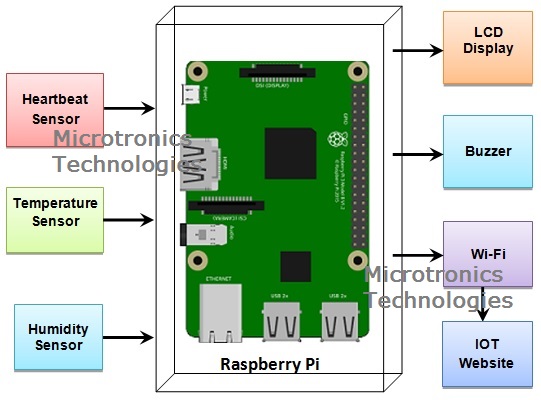The monitoring of health-related vital parameters of a patient in a hospital ICU cannot be overemphasized. Most of the time, it is not possible for the doctors or paramedical staff to keep an eye on the vital parameters of a patient 24/7 because they have to attend to other patients as well. If any of the vital parameters of the patient become abnormal, then the paramedical staff has no way of getting informed about it automatically. IOT Based ICU Patient Monitoring System can help solve this purpose.

₹ 13,800
Project Code: 6151

Description of the project
Smart IOT based technologies can be employed for the efficient monitoring of a patient in the ICU. A smart IOT based ICU patient monitoring project is proposed for this purpose. The IOT connectivity and the digital controller are used to create a smart patient monitoring system. The system utilizes temperature, humidity, and blood pressure sensors to monitor the vital signs of a patient. Diastolic pressure, systolic pressure, and heart rate can be measured using the blood pressure sensor. If any of these vital signs go beyond a certain limit, an alarm buzzer is turned in to notify the concerned personnel.
The power supply module converts 220V AC to 5V DC. The temperature sensor measures the patient’s body temperature, humidity sensor measures the ambient humidity and the blood pressure sensor measures diastolic pressure, systolic pressure and heart rate of the patient.
The data provided by the three sensors is fed to the Raspberry Pi controller which stores and processes this data. The Raspberry Pi is a single board computer which interacts with the input and output devices. The Raspberry Pi controller displays the sensor data on an LCD screen. If any of the sensor values go beyond a certain threshold value, an alarm buzzer is turned on to notify the concerned staff.
The Raspberry Pi controller also sends the sensor data to a remote server based IOT platform by means of on-board WiFi and IOT protocols. The Raspberry Pi controller is programmed using Python language and runs a Linux based OS known as Raspbian. The IOT platform being used in called ThingSpeak. A graphical user interface is built on the Thingspeak IOT platform to show the sensor data in a graphical format.
Description of the block diagram
The project block diagram of the IOT based ICU patient monitoring project consists of multiple subsystems and blocks. A description of these blocks is given as follows:
- The power supply subsystem converts 220 VAC to 5VDC stable output to run the DC devices.
- The temperature sensor measures the body temperature of the patient and sends this data to Raspberry Pi controller.
- The humidity sensor measures the ambient humidity in the ICU and sends this data to the Raspberry Pi controller.
- The blood pressure sensor measures the systolic pressure, diastolic pressure, and heart rate of the patient and sends off this data to the Raspberry Pi controller.
- The LCD display is connected to the output of the Raspberry Pi controller and is used to display the sensor data values.
- The buzzer is also connected to the output of the Raspberry Pi controller. The buzzer is switched on when a sensor value crosses a certain threshold.
- The Raspberry Pi controller subsystem is responsible for all the storage, processing, and transmission of data. The controller is interfaced with all other input, output, and peripheral subsystems. The controller also houses built-in WiFi for IOT communication.
- The remote server based IOT platform known as ThingSpeak is a critical subsystem in the project and is used for remote storage, monitoring and visualization of the received sensor data. The data is displayed in a graphical format by means of a GUI.
Applications, advantages, and enhancements of IOT Based ICU Patient Monitoring System
- The IOT based ICU remote patient monitoring project is used for remote monitoring of the patients by the doctors and paramedical staff.
- IOT based ICU remote patient monitoring project is built from reasonably priced components and hence, it is an economically feasible project.
- A camera system can be included in the project to remotely monitor the patient in a more effective manner.
- An additional button can be added in the system so that paramedical staff can be called upon by the attendants in case of emergency.
Block diagram of the IOT Based ICU Patient Monitoring System project

